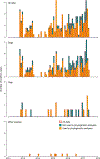Use of partial N-gene sequences as a tool to monitor progress on rabies control and elimination efforts in Ethiopia
- PMID: 34161816
- PMCID: PMC8652542
- DOI: 10.1016/j.actatropica.2021.106022
Use of partial N-gene sequences as a tool to monitor progress on rabies control and elimination efforts in Ethiopia
Abstract
Ethiopia is one of the African countries most affected by rabies. A coarse catalog of rabies viruses (RABV) was created as a benchmark to assess the impact of control and elimination activities. We evaluated a 726 bp amplicon at the end of the N-gene to infer viral lineages in circulation using maximum likelihood and Bayesian methods for phylogenetic reconstruction. We sequenced 228 brain samples from wild and domestic animals collected in five Ethiopian regions during 2010-2017. Results identified co-circulating RABV lineages that are causing recurrent spillover infections into wildlife and domestic animals. We found no evidence of importation of RABVs from other African countries or vaccine-induced cases in the area studied. A divergent RABV lineage might be involved in an independent rabies cycle in jackals. This investigation provides a feasible approach to assess rabies control and elimination efforts in resource-limited countries.
Keywords: Co-circulating lineages; Dog rabies; Monitoring elimination; Resource-limited countries.
Copyright © 2021. Published by Elsevier B.V.
Conflict of interest statement
Declaration of Competing Interest
No conflict of interest declared.
Figures


References
-
- Carnieli P, Ruthner Batista HBC, de Novaes Oliveira R, Castilho JG, Vieira LFP, 2013. Phylogeographic dispersion and diversification of rabies virus lineages associated with dogs and crab-eating foxes (Cerdocyon thous) in Brazil. Arch. Virol. 158, 2307–2313. 10.1007/s00705-013-1755-y. - DOI - PubMed
MeSH terms
Grants and funding
LinkOut - more resources
Full Text Sources
Medical

